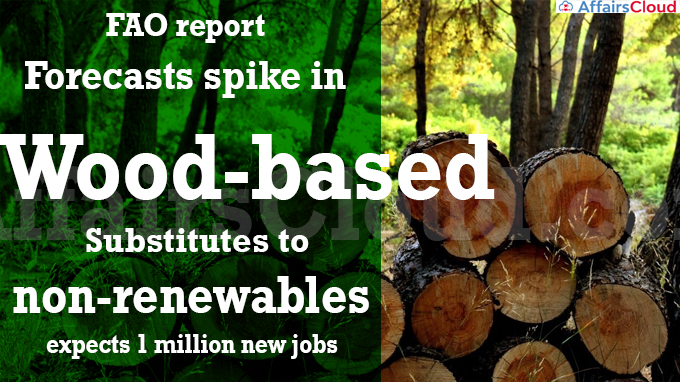 According to the “Global forest sector outlook 2050: Assessing future demand and sources of timber for a sustainable economy – Background paper for The State of the World’s Forests 2022 (Provisional)” the global threats to climate, biodiversity and a healthy environment are mainly caused by the excessive use of non-renewable materials.
According to the “Global forest sector outlook 2050: Assessing future demand and sources of timber for a sustainable economy – Background paper for The State of the World’s Forests 2022 (Provisional)” the global threats to climate, biodiversity and a healthy environment are mainly caused by the excessive use of non-renewable materials.
- The report stated that the demand for wood products such as mass timber and man-made cellulose fibre, a substitutes for non-renewable materials, may increase by up to 272 million cubic metres by 2050.
The report was released by the Food and Agriculture Organization of the United Nations(FAO) during 26th Session of the FAO Committee on Forestry(COFO26) held in Rome, Italy.
- The report aims to identify the potential supply gaps and needs in forest industries in round wood production, investments and employment.
Note – FAO’s 8th World Forest Week (WFW2022) was observed from 29th September 2022 to 7th October 2022 with theme “Growing a better planet”.
Key Findings:
i.According to the “Global forest sector outlook 2050”, primary processed wood products such as sawnwood, veneer / plywood, particle / fibreboard and wood pulp are expected increase to 3.1 Billion Cubic Metre (bcm) by 2050 from 2.2 bcm in 2020.
ii.The report also predicts that the Industrial Roundwood (IRW) will face uncertainties arising from climate change driven policy interventions in naturally regenerated production forests as well as the productivity and expansion of planted forests.
iii.The demands of IRW shall be met by a combination of planted forests particularly from the Global South and naturally regenerated temperate and boreal forests.
iv.The report stated that, In 2020, the naturally regenerated temperate and boreal forests provided more than 44% of the global IRW production.
- If the area of the naturally regenerated forests remains constant, an additional 33 million hectares of ‘highly productive plantation forest’, will be needed to meet the increasing demand of IRW up to 2050.
v.The report also highlighted that, a total of USD 40 billion (~ Rs 3.3 lakh crore) per annum in investment will be needed to maintain and expand IRW production by 2050 and another USD 25 billion per annum will be needed to modernise and to establish industries.
Wood Energy Consumption:
i.According to the report, the wood energy consumption by 2050 is expected to shaped by the traditional use of fuelwood in Sub Saharan Africa and Southern Asia.
ii.The global consumption volumes of fuelwood from forests in 2050 may be between 2.3 and 2.7 bcm, compared to 1.9 bcm in 2020(an 11-42% rise) .
iii.By the end of 2020, around 2.3 billion people were still relying on wood fuel as their primary source of energy for cooking and heating. This will be te main source of energy for households in emerging economies till 2050.
Recent Related News:
On 2nd May 2022, Food and Agriculture Organization of the United Nations (FAO) released its flagship publication “The State of the World’s Forests (SOFO) 2022: Forest Pathways for Green Recovery and Building Inclusive, Resilient and Sustainable economies”. This is part of The State of the World series of the FAO.
About Food and Agriculture Organization of the United Nations(FAO):
Director-General– Qu Dongyu
Headquarters– Rome, Italy




